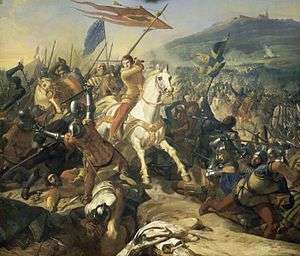Battle of Mons-en-Pévèle
| Battle of Mons-en-Pévèle | |||||||
|---|---|---|---|---|---|---|---|
| Part of the Franco-Flemish War | |||||||
 The Battle of Mons-en-Pévèle, by Charles Philippe Larivière (1839) | |||||||
| |||||||
| Belligerents | |||||||
|
|
| ||||||
| Commanders and leaders | |||||||
|
|
Philip of Chieti | ||||||
| Strength | |||||||
|
3,000 Knights[2] 10,000 Infantry[2] | 12,000–15,000[3] | ||||||
| Casualties and losses | |||||||
| 1,800[4]–7,000[5] | 7,000–8,000[5] | ||||||
The Battle of Mons-en-Pévèle (or Pevelenberg) was fought on 18 August 1304 between the French and the Flemish. The French were led by King Philip IV "the Fair" in person.
Prelude
The French King wanted revenge for the defeat in Battle of the Golden Spurs in 1302, after which the Flemish had retaken Douai and Lille. By the beginning of 1304, the French king was ready to attack the Flemish rebels. While the French army, led by the king himself, marched north to attack William of Julich's force, the French navy sailed to Zeeland to unite with the army of Hainault and Holland. It was this combined northern force in Zeeland which struck the first blow on 10–11 August 1304 when it soundly defeated Guy of Namur's army and navy at the Battle of Zierikzee; Guy was captured and the Flemish conquest of Holland was halted.[6]
Philip of Chieti, son of Count Guy, Count of Flanders, had gathered a strong Flemish army to stop the French invasion and taken up positions on the Pévèle hill.
The battle
After a day of fighting the outcome was undecided and negotiations were opened between 17:00 and 18:30. When a French force under Guy de Saint-Pol tried to surround the Flemish, he was pushed back. Now the furious Flemish decided to launch a frontal attack, and surprised the French, who thought the battle was over for the day.
The Flemish had reached the royal tent, attacking King Philip IV of France. He only escaped because some knights around him covered his flight, paying for this act with their lives.[7] Assisted with mounting his horse, Philip counterattacked, but had his horse killed under him.[8] By then William of Jülich was killed in a counterattack that the King had managed to launch.[9]
As only the Flemish right wing had attacked, and the left wing under John I, Marquis of Namur was already leaving the battlefield,[7] the Flemish right wing also withdrew.
The French chose not to pursue the Flemish.
During the Flemish attack on Philip, the oriflamme was lost.[3] A hugely symbolic and significant flag.[3]
Aftermath
Both sides claimed victory: but the French remained in possession of the battlefield and forced a Flemish retreat. The French also conquered Douai and Orchies and burned down Seclin.
After further minor battles, eventually the Treaty of Athis-sur-Orge was signed on 23 June 1305 which recognized Flemish independence, at the cost of the cities of Lille, Douai and Béthune,[5] which were transferred to France, and the paying of exorbitant fines to King Philip IV.
Notes
- 1 2 Curveiller 1989, p. 34.
- 1 2 DeVries 2006, p. 34.
- 1 2 3 DeVries 2006, p. 35.
- ↑ Verbruggen 1997, p. 203.
- 1 2 3 DeVries 2006, p. 33.
- ↑ DeVries 2006, p. 32.
- 1 2 DeVries 2006, p. 40.
- ↑ DeVries 2006, p. 41.
- ↑ DeVries 2006, p. 44.
References
- Curveiller, Stephane (1989). Dunkerque, ville et port de Flandre à la fin du Moyen âge: à travers les comptes de bailliage de 1358 à 1407. Presses Univ. Septentrion.
- DeVries, Kelly (2006). Infantry Warfare in the Early Fourteenth Century: Discipline, Tactics, and Technology. The Boydell Press.
- Six, Georges (1905). "La bataille de Mons-en-Pévèle (18 août 1304)". Annales de l'Est et du Nord. 1 (2).
- Verbruggen, J. F. (1952). "De slag bij de Pevelenberg". Bijdragen voor de geschiedenis der Nederlanden. 6: 169–98.
- Verbruggen, J. F. (1997). The Art of Warfare in Western Europe During the Middle Ages: From the Eighth Century to 1340. The Boydell Press.
- Verbruggen, J. F. (2002) [1952]. The Battle of the Golden Spurs: Courtrai, 11 July 1302 (rev. ed.). Woodbridge: Boydell Press. ISBN 0-85115-888-9.